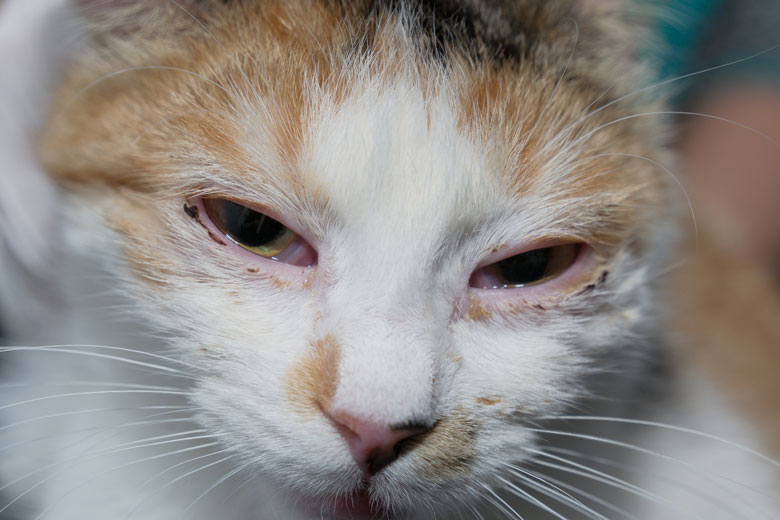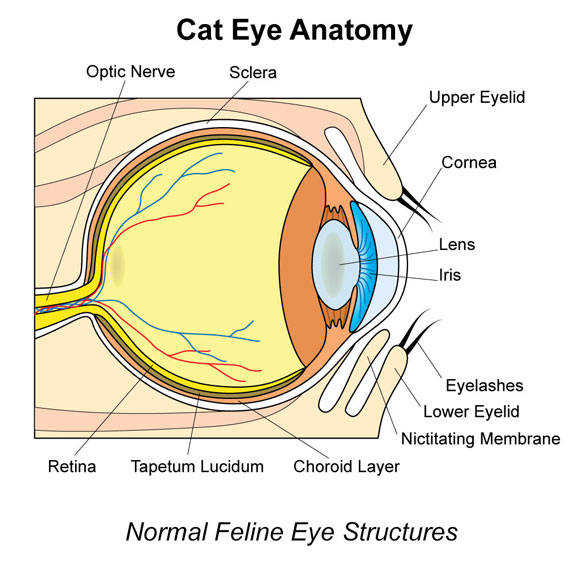Conjunctivitis in Cats

Conjunctivitis is an extremely common condition in cats. If you have cats, it's highly likely you will have to deal with it at some point. It's good to know what it is and what can cause it.
What Is Conjunctivitis in Cats?
Conjunctivitis is the inflammation of the conjunctiva of the eye. The conjunctiva is a thin mucous membrane that covers the eyes and lines the insides of the eyelids (see the diagram of a healthy feline eye). Its purpose is to secrete mucous that keeps the cornea moist and to protect the eye. Cats have a third eyelid, the nictating membrane, which can come over the eye from the bottom inner portion, and that also has conjunctiva.
What Are the Signs of Feline Conjunctivitis?

Normally, it's not easy to see the conjunctiva. It's pale and slightly pink. During conjunctivitis, the conjunctiva can become red, swollen, and obvious.
A cat with conjunctivitis might have tearing of the eye, may squint, and could rub at the eye. When the conjunctiva of the third eyelid is involved, the eye could be partly covered by the swollen tissue, giving the cat the look of having its eye rolling back (it isn't really doing that).
What Causes Conjunctivitis in Cats?
The most common causes of feline conjunctivitis include:
- Infections with bacteria, viruses, or fungi, such as those below:
- Feline herpesvirus
- Feline calicivirus
- Chlamydia
- Mycoplasma
- Strep
- Staph
- Non-infectious conditions, including the following:
- Entropion
- Trauma
- Allergies
- Tumors
How Is Feline Conjunctivitis Diagnosed?
Anytime you believe something is going on with your cat's eye, you should make an appointment with a veterinarian. The vet will do a thorough examination of your cat and an ophthalmologic exam of the eyes themselves.
Some other tests your vet might do to determine the source of the problem include a Schirmer tear test to evaluate tear production, an intraocular pressure test to evaluate for glaucoma or uveitis, and a stain test to look for corneal ulcers.
Your vet may also wish to do other tests to evaluate your cat's general health, such as a fecal test, blood work, or a urinalysis.
What Is the Treatment for Conjunctivitis in Cats?
Treatment of conjunctivitis includes using a topical anti-inflammatory medication (ointment or drops) and anti-bacterial (because bacteria often play a primary or secondary role in conjunctivitis). If there are signs of systemic illness, such as sneezing to indicate allergies or upper respiratory infection, oral medications may also be used.
The cat will be observed carefully for their response to the treatment for several days. If at any time, the eye seems worse, a recheck is immediately necessary.
If an exact diagnosis is made of an underlying condition, further medications may be required. Feline herpesvirus, a common cause of conjunctivitis, is a virus that is not ever fully eliminated from the body. Those cats may get conjunctivitis flare-ups periodically and need treatment.
You May Also Like These Articles:
Eye Problems in Cats: An Overview
Eye Infections in Young Kittens



